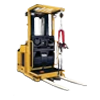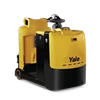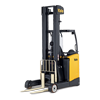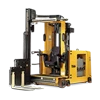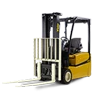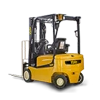Stay Safe
20 Tips For Sale
Handling
To help ensure safe lift truck operation, we have
compiled 20 top forklift safety tips.
20 Tips For Safe Lift Truck
Operation
To help ensure the correct operation of fork lift trucks, we have compiled a quick reference guide for operators of materials handling equipment. For detailed information regarding forklift safety and onsite support and training to ensure compliance with health and safety regulations, your local Yale® dealer will be pleased to help.
- Only those employees who have been trained, authorised and licensed should operate materials handling equipment.
- Operators should be appropriately dressed – the correct safety equipment, including hi-visibility jacket, safety shoes and hard-hats (where appropriate) should always be worn.
- Remember loose clothing can become caught on the truck or may interfere with controls.
- Materials handling equipment should always be thoroughly inspected and daily checks made before starting work with the shift supervisor being informed if any problems are identified.
- The equipment operating instructions in the operator manual should always be followed.
- Equipment which requires repair should never be operated and repairs and maintenance only carried out by qualified technicians, for example the supplier’s service engineer.
- Never operate materials handling equipment with wet or greasy hands or shoes as they could slide off the controls and cause an accident.
- Always use the steps and hand grabs provided to get on and off the equipment.
- Before commencing work ensure that a comfortable operating position is found and all controls are within easy reach. The armrest, seat position and mirrors should be correctly adjusted and the safety belt should always be fastened.
- Never operate a lift truck unless you are in the operator’s seat and keep arms, legs and head inside the confines of the truck at all times.
- Follow all the work site rules, regulations and restrictions and only operate equipment on designated roadways and specified areas.
- Observing all warning signs.
- Always look in the direction of travel and be fully aware of what is happening in the surrounding areas.
- Always operate equipment within designated speed limits.
- Travel slowly when turning corners or going round bends as the combination of speed and the sharpness of a turn can result in a tip over.
- Do not stop, start, turn or change direction suddenly.
- Avoid bumps, holes, loose materials and use extra caution when the floor is slippery.
- Do not drive over objects such as pieces of wood scattered on the ground as doing this could cause the load to move or control of equipment could be lost.
- Reduce the speed of equipment and use the horn when in the proximity of corners, exits, entrances, stairways, doors, pedestrian walkways and in the vicinity of other employees.
- Unless absolutely necessary do not operate equipment in close proximity to other equipment being used
- Keep a safe distance from other equipment in case they move in an unpredictable manner.
- Always have enough space to stop safely.
- Handle loads carefully and check them closely for stability and balance before raising, lowering or moving off. Falling loads can cause injury and damage.
- Travel with the load tilted back and the forks as low as possible as this will increase the stability of the equipment being operated.
- Never travel with the forks raised high above the floor or turn with the forks in an elevated position or tilted forward.
- Look out for overhead obstructions when lifting, lowering or stacking loads.
- Be alert to the possibility of falling loads when stacking.
- Carrying a load close to the floor provides good forward visibility.
- Operate equipment in reverse when the load restricts visibility, except when moving up ramps.
- Ensure that there is a good view of the rack or the top of a stack when positioning a load.
- When reversing ensure the forks are tilted back completely and confirm that the load is safely secured before moving off.
- If visibility remains obstructed always stop and confirm it is safe to proceed. In these circumstances, a lookout or helper may be required.
- Do not let other people ride on the equipment unless a second seat is fitted. Fork lift trucks for example are designed to carry loads, not people.
- Do not use forklift trucks to lift people. If a person has to be lifted, use only a securely attached work platform and cage and follow the appropriate operating instructions.
- Do not permit anyone to stand or walk under a load, lifting mechanism or attachment as the load could fall and cause serious injury to anyone standing below.
- Never place hands or feet on the cross members of a lift truck mast as serious injury will be caused if the mast is lowered while your hands or feet are on it.
- Remember to drive up gradients in a forward direction and down in reverse, especially while carrying loads.
- Do not load or unload goods or turn while on a ramp.
- Do not lift or move loads that are not safe or stable.
- Make sure loads are correctly stacked and positioned across both forks.
- Stack the load on the pallet or skid safely and correctly.
- Use ropes or bindings to secure loads if required.
- When moving long, high, or wide loads operate equipment with increased care.
- Look out for other people or obstructions in your path of travel.
- Do not use fork tips as a lever to raise a heavy load.
- Do not push a load with fork tips or use the tilt cylinder to pull a load.
- Do not overload equipment or add extra weight to the counterweight of a fork lift truck.
- Know and never exceed the capacity of equipment and any attachments being used. Overloading equipment can cause the rear wheels to be raised off the ground and could cause equipment to tip over causing injury to personnel or damage to equipment or goods.
- Do not lift or move a load unless both forks are positioned fully under the load.
- Do not lift a load with one fork.
- Use pallets and skids that are appropriate for the weight of the load.
- Do not use damaged or decayed pallets or skids.
- Take extra care and make sure that round, tall, long or wide loads are balanced and well secured.
- Turn and work slowly to prevent the load from moving.
- Ask someone to help when space to maneuver is restricted and make sure you follow the signals given by a helper.
- Observe all warning signs particularly those on maximum permitted floor loadings and clearance heights, which may differ across the work site.
- Be aware of the height of the load, mast and overhead guard of equipment particularly fork lift trucks when entering or exiting buildings.
- Be careful when operating equipment on a loading dock or ramp by keeping a safe distance from the edge as equipment could fall over and cause injury or loss of the load.
- Do not operate equipment on bridge plates, unless they support the weight of equipment and the load.
- Equipment should only be recharged or refuelled at specially designated locations.
- Always switch off equipment while being recharged or refuelled.
- Refuelling of engine powered trucks should take place in a well-ventilated, spark and flame free area.
- Always park equipment in the designated or authorised area.
- Fully lower forks to the floor and apply the park brake.
- Turn the equipment “off” and remove the key.



